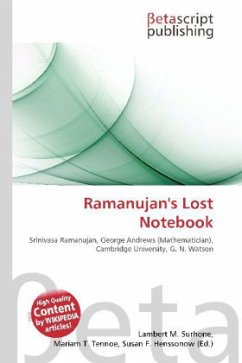
Ramanujan's Sum
Versandkostenfrei!
Versandfertig in 6-10 Tagen
26,99 €
inkl. MwSt.

PAYBACK Punkte
13 °P sammeln!
Please note that the content of this book primarily consists of articles available from Wikipedia or other free sources online. In number theory, a branch of mathematics, Ramanujan''s sum, usually denoted cq(n), is a function of two positive integer variables q and n defined by the formula c_q(n)= sum_{a=1atop (a,q)=1}^q e^{2 pi i tfrac{a}{q} n} ,where (a, q) = 1 means that a only takes on values coprime to q.Srinivasa Ramanujan introduced the sums in a 1918 paper. In addition to the expansions discussed in this article, Ramanujan''s sums are used in the proof of Vinogradov''s theorem that eve...
Please note that the content of this book primarily consists of articles available from Wikipedia or other free sources online. In number theory, a branch of mathematics, Ramanujan''s sum, usually denoted cq(n), is a function of two positive integer variables q and n defined by the formula c_q(n)= sum_{a=1atop (a,q)=1}^q e^{2 pi i tfrac{a}{q} n} ,where (a, q) = 1 means that a only takes on values coprime to q.Srinivasa Ramanujan introduced the sums in a 1918 paper. In addition to the expansions discussed in this article, Ramanujan''s sums are used in the proof of Vinogradov''s theorem that every sufficiently-large odd number is the sum of three primes.












